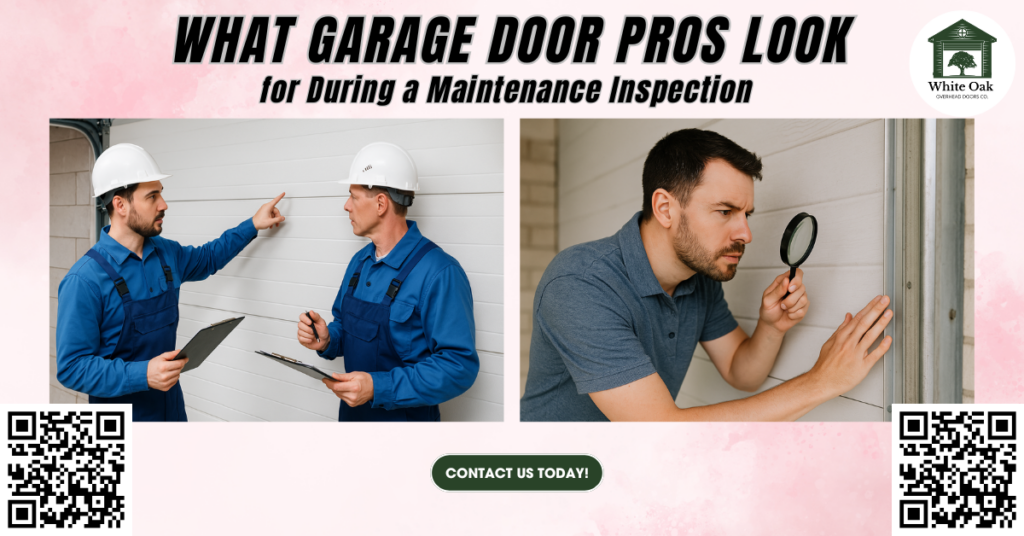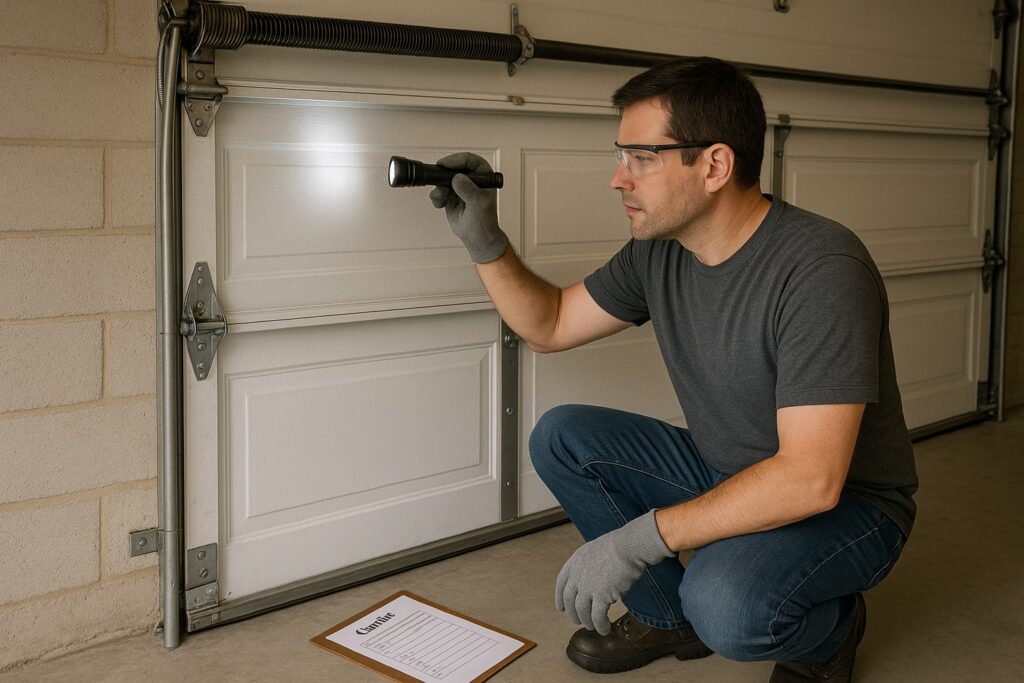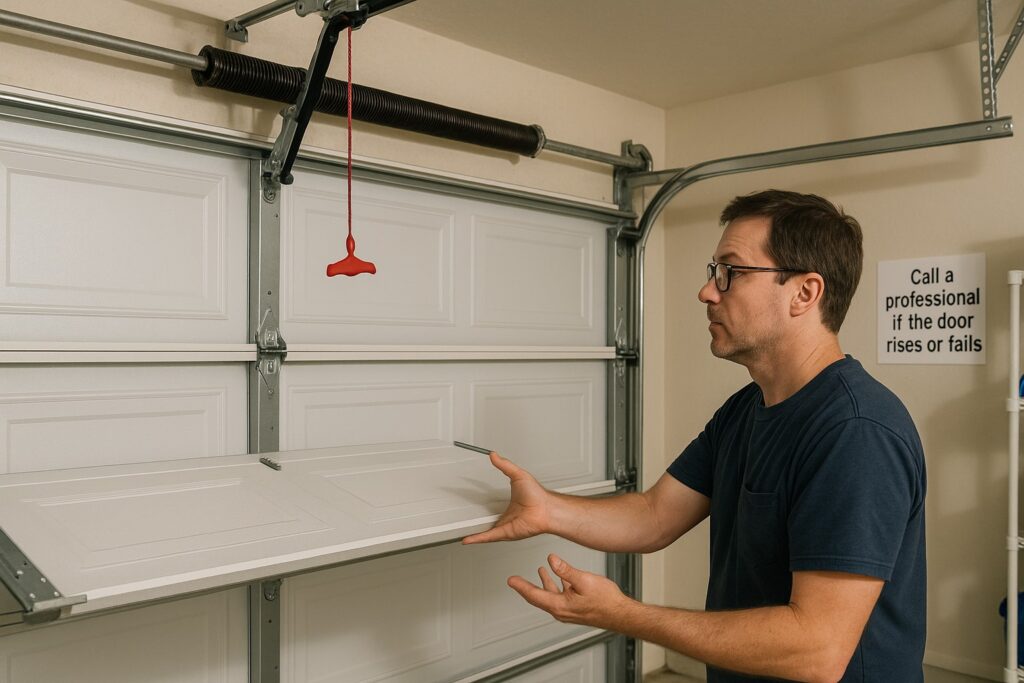What Garage Door Pros Look for During a Maintenance Inspection

L
A Real-Life Reminder: The Importance of Regular Maintenance
One warm afternoon in Houston, TX, we got an urgent call. A local homeowner had just experienced a garage door failure that trapped their vehicle inside during school pickup time. With one of the torsion springs broken and the door misaligned on its track, the situation could have turned dangerous. Fortunately, our technician was on-site within hours and resolved the issue. But it made one thing very clear: regular garage door maintenance could have prevented the problem.
According to the U.S. Consumer Product Safety Commission, garage doors are responsible for over 20,000 injuries annually. These range from minor pinches to serious harm caused by broken springs, failed openers, or misaligned tracks. And in many cases, the source is the same: lack of routine inspection and upkeep.
At White Oak Overhead Doors Co., we serve homeowners and business owners across Houston, TX, and surrounding communities with reliable garage door installation, repair, and maintenance. This article is your complete guide to understanding what professional garage door technicians look for during a detailed maintenance inspection. We also highlight essential tasks, parts, and safety features involved in a fully operational garage system.
Routine maintenance is not just a technical checklist, it is an important safety measure and a smart investment in your home’s future. Let’s explore what that looks like in practice.
What Is Garage Door Maintenance?
Garage door maintenance is a preventative service designed to keep your garage door system in top shape. It involves a full-scale evaluation of all components, including the garage door opener, torsion springs, rollers, tracks, hinges, weather stripping, arm bar, brackets, cables, sensors, and door panels. These parts must function together to ensure consistent and quiet operation.
The goal of regular maintenance is to:
- Prevent unexpected breakdowns and malfunctions
- Extend the lifespan of your garage door system
- Ensure your family’s safety
- Reduce the need for emergency garage door repair services
- Maintain proper energy efficiency and insulation
- Enhance the door’s aesthetic value and curb appeal
Properly maintained garage doors can last 15 to 30 years, depending on the materials, climate, and usage. Think of it like a checkup for your home’s largest moving part. Routine upkeep also keeps warranties valid and helps identify manufacturer defects early.
Step-by-Step Inspection: What We Check and Why It Matters
1. Visual Scan of Door Components
This is the first step in our detailed inspection. We assess the visual condition of:
- Garage door panels: Cracks, rust spots, scratches, dents, or signs of water damage (especially in wood doors). Damaged panels may compromise the structural integrity or insulation value of the door.
- Weatherstripping and sealant: Degraded or missing weather stripping can let in pests, moisture, and outdoor air, which harms insulation and efficiency. Damaged seals are especially problematic in regions with intense weather like Houston, TX.
- Track alignment: Tracks must be clean, free of debris, and perfectly aligned. Misalignment affects roller travel and strains the opener.
- Hinges and roller brackets: We look for loose bolts, rust, metal fatigue, and signs of stress that can lead to door misalignment or collapse. These metal parts often wear down due to vibrations from frequent use.

This early detection step helps us catch problems before they become expensive repairs.
2. Testing the Garage Door Opener System
The garage door opener is the powerhouse behind your automatic opener system. Whether you’re using a traditional chain drive or a StealthDrive Connect for smart features and quiet operation, we:
- Confirm functionality of remotes, wall switches, and backup batteries
- Evaluate noise levels from the opener and drive assembly
- Inspect the top rail and arm bar for alignment and tightness
- Check that the door opens and closes within optimal timing parameters
- Examine compatibility and updates for smart systems with app control
- Test the limit settings and force adjustments for correct operation
A failing opener may cause delayed reaction, noisy performance, or complete door inoperability. We also check for any signs of power fluctuations, which can affect sensitive electronics in modern systems.
3. Garage Door Springs: Torsion and Extension Types
Springs do the heavy lifting and are among the most critical parts in your garage system. We inspect both torsion springs and extension springs for:
- Proper tension balance (we use a manual lift test)
- Signs of fatigue, like cracks, rust, or gaps between coils
- Fraying in cables connected to the spring system
- Lubrication levels and rust accumulation
Most torsion springs last about 7-10 years or around 10,000 cycles. Neglecting them can cause sudden door slamming or personal injury. In severe cases, snapped springs can fly loose and cause significant damage to vehicles or the structure of the garage.
4. Garage Door Rollers and Roller Brackets
Garage door rollers enable smooth operation along the metal tracks. We check for:
- Cracks or chips in nylon, plastic, or metal rollers
- Lack of lubrication or dried-out bearings
- Loose, bent, or rusted roller brackets
- Excessive noise during movement, a sign that garage door lubricant or replacement is needed
- Wear-and-tear consistent with high-use cycles
Replacing worn-out rollers can significantly reduce stress on your garage door opener and increase its lifespan. Properly functioning rollers are also essential for maintaining door alignment and reducing wear on the track system.
5. Track Alignment and Hardware Condition
The metal tracks guide your garage door as it opens and closes multiple times a day. We:
- Use level and square tools to measure alignment
- Clean tracks of dust, debris, or grease using vacuuming or compressed air
- Tighten track bolts and nuts using a socket wrench
- Look for signs of corrosion, warping, or loose mountings
- Check track spacing for uniformity across the vertical and horizontal sections
Bent tracks can cause misalignment, strain the opener, and result in emergency service calls. Maintaining them ensures a consistent travel path and prolongs the lifespan of your garage door rollers.
6. Cable and Pulley Systems
Cables and pulleys transfer power from the springs to lift the door evenly. We inspect:
- Lift cables for frays, rust, or unraveling
- Pulley bearings for resistance and squeaking
- Proper alignment of the drum and shaft
- Even tension across both sides of the door
- Look for spooling irregularities that could indicate installation issues
A worn cable can snap under tension, damaging parts and risking injury. We often recommend replacing cables every 5-7 years in high-use systems.
7. Safety Features: Sensors and Auto-Reverse
All modern garage doors include safety sensors and an auto-reverse feature. To verify your safety systems, we:
- Clean sensor lenses and test alignment
- Simulate obstruction to check auto-reverse response time
- Review panel lights and test electrical connectivity
- Inspect wiring for corrosion, fraying, or loose connections
- Confirm compliance with UL 325 safety standards
These features prevent accidents involving children, pets, or vehicles. Faulty sensors can lead to malfunctioning doors that pose serious risks.
8. Lubrication of Moving Parts
A key preventative maintenance task is lubrication. We apply:
- White lithium grease for hinges, torsion springs, and bearings
- Spray lubricant designed for garage doors on rollers and tracks
- Avoid DIY greasing with engine oils or vegetable sprays, which attract dirt
- Ensure even application across all moving parts to minimize friction
Lubrication reduces wear on metal parts, ensures quiet operation, and helps your system work in extreme weather conditions. Consistent lubrication also prevents moisture accumulation that leads to rust.
9. Tightening and Adjustment of Hardware
Over the years, repeated use causes hardware to loosen. Using a socket wrench, we tighten:
- Hinges and brackets
- Mounting bolts on the opener and wall fasteners
- Loose screws along the door frame and opener carriage
We also inspect the arm bar, roller brackets, and tension plates for wear or improper alignment. Proper tightening ensures the system operates smoothly and prevents noisy or jerky movement.
10. Weatherstripping and Bottom Seals
Proper seals help keep out rain, wind, and dust. We examine:
- Rubber seals for cracking or flaking
- Compression of seals against the floor and side frames
- Sealant adhesion on wood or metal surfaces
- Application of fresh weather stripping or caulking where needed
Good sealing reduces energy bills and prevents moisture buildup. It also improves insulation, especially in garages that connect to climate-controlled living spaces.
11. Door Balance and Manual Operation Test
A well-balanced door should stay in place when lifted halfway manually. We:
- Use the release handle to disengage the automatic opener
- Lift and lower the door, checking for smooth, effortless movement
- Monitor for slamming or rising, which signals spring issues

This test is crucial for ensuring safe operation and reducing wear on the opener. Improper balance leads to uneven strain on the drive system and can shorten its lifespan.
12. Testing the Battery Backup and Control Panels
We check the emergency backup systems that keep your garage functioning during power outages. This includes:
- Replacing expired batteries
- Cleaning battery contacts to remove corrosion
- Confirming that wall panel displays are readable and responsive
- Testing Wi-Fi and app functionality for smart openers
- Running a full power outage simulation to verify emergency functionality
Backup power helps maintain access and security during storms or outages. It’s a critical feature in areas prone to extreme weather.
When Should You Schedule Garage Door Maintenance?
Recommended Maintenance Frequency:
- Residential garage doors: Annually
- Commercial garage doors: Biannually or every 5,000 open/close cycles
- Homes with high use: Every 6-8 months
- Before seasonal changes: Spring and fall are ideal for lubrication and inspection
Warning Signs You Need Maintenance Now:
- Loud grinding or squeaking noises
- Delayed opener response or failure
- Sagging or slamming door
- Broken garage door springs or cables
- Rust spots or track misalignment
- Remote control or wall panel errors
Immediate attention can prevent more costly repairs and maintain your family’s safety.
Garage Door Maintenance Tips for Homeowners
While complex tasks are best left to professionals, here are some DIY guide-friendly tips:
- Vacuum tracks regularly to remove dirt and dust
- Spray lubricant on rollers and hinges every 3-6 months
- Test auto-reverse with a soft item placed on the floor to ensure safety sensors work properly
- Inspect weather stripping for tears, cracks, or shrinking
- Watch the door movement for jerks, hesitation, or uneven lifting
- Check the garage door opener light and test the remote range to detect power or battery issues
Avoid attempting to adjust torsion springs, cable drums, or high-tension parts without proper training. These components can cause injury if mishandled.
Differences Between Residential and Commercial Maintenance
Residential Maintenance:
- Designed for 2-4 daily cycles
- Focuses on aesthetics, noise reduction, and safety
- Standard-size steel or wood doors
- Typically, one or two openers per system
- Emphasis on visual appeal and quiet operation
Commercial Maintenance:
- Doors may be larger, roll-up, or sectional
- Used multiple times daily, requiring heavy-duty bearings, hinges, and tracks
- Prioritizes durability, cycle longevity, and compliance with safety codes
- Involves more rigorous inspections and hardware adjustments
- May require faster response due to operational needs
Our team adjusts service protocols to suit the unique challenges of both home and business garage systems.
Final Thoughts: Why Garage Door Maintenance Is Essential
Your garage door is more than just a convenience; it’s a key part of your home’s safety, curb appeal, and energy efficiency. Ignoring maintenance can lead to unexpected failures, expensive repairs, or worse, injury to your family.
Whether you’re a tech-savvy homeowner using smart openers or a traditionalist with a classic steel door, garage door maintenance protects your investment. Schedule inspections multiple times a year if your garage serves as the main entry to your home.
A neglected garage door may work for a while, but eventually, the wear and tear catch up. Performing maintenance tasks consistently ensures peace of mind and keeps your door operating safely for years.
Professional services provide the tools, knowledge, and attention to detail required to spot issues early and maintain all garage door parts, from tracks and rollers to openers and sensors.
How Can White Oak Overhead Doors Co. Help You?
If you’re in Houston, TX, we’re your local experts in all things garage door. Our services include:
- Annual garage door maintenance and safety checks
- Emergency replacement for garage door springs and cables
- Smart garage door opener upgrades
- Full garage door installations using steel, wood, and composite materials
We deliver top-quality results backed by years of experience, premium tools, and a dedication to your safety.
White Oak Overhead Doors Co.
(832) 990-1595
Let us take care of your garage door, so you can enjoy safer, quieter, and longer-lasting performance every day.
Frequently Asked Questions (FAQs)
1. Can I use WD-40 to lubricate my garage door parts?
No, WD-40 is a cleaner and degreaser, not a lubricant; use white lithium grease or a silicone-based spray designed specifically for garage doors.
2. How long does a professional garage door maintenance visit usually take?
A standard inspection and tune-up typically takes between 45 minutes to 1.5 hours, depending on the condition and type of door system.
3. What is the average cost of garage door maintenance service?
On average, a routine maintenance service ranges from $100 to $200, depending on complexity and location.
4. Is garage door maintenance covered by homeowners’ insurance?
Most standard policies do not cover routine maintenance, but sudden damage due to covered perils may be eligible under specific circumstances.
